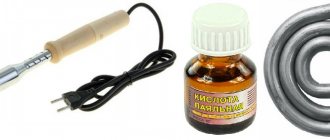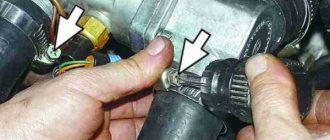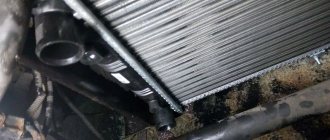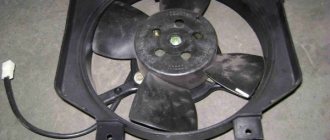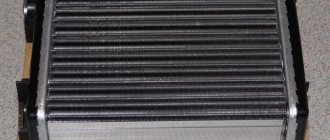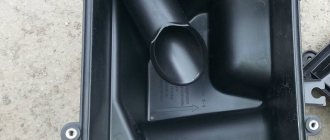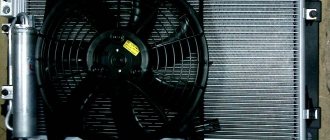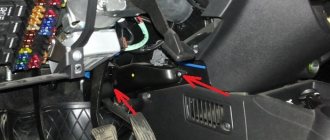Cooling radiator for VAZ cars
VAZ 2114 is considered one of the most striking examples of success of the domestic automobile industry. This model is a modified version of the VAZ 2109 and differs from it in the design of the front part of the body, updated headlights and hood, radiator grille design, as well as plastic moldings and spoilers. However, as it became known, the car is susceptible to radiator failures, which can lead to overheating, and as a result, to engine failure.
Required spare parts
First of all, you need to select a new radiator. It is better to purchase an analogue of what is on your car. You can also make a choice by article number: 2108-1301012, 21082-1301012, RO2108-01, LRc 01082.
The average price of a new unit is 1,750 rubles. Copper models will cost more.
Attention ! It is better not to purchase painted radiators, since there is a risk of an unpleasant odor appearing in the interior, and the heat transfer of these models is lower.
What determines the cost of a radiator?
There are several factors that affect the final cost of a given element.
The first is the manufacturer . Original spare parts are always very expensive, so many car owners try to replace them with imported analogues in the event of a breakdown. Today, the following companies are in great demand in the Russian car market:
- DAAZ.
- BAKER.
The second is the characteristics of the radiator . For this car model, the radiator is made of two types of metal: copper and aluminum. Each of them has its own unique characteristics that allow it to perform better.
This heat exchanger has no varieties, apart from its design. Therefore, the specific cost will be based only on the characteristics.
Tools required for repairs
If you want to do the repairs yourself, you need to prepare the following tools:
- keys for 8 and 10;
- screwdrivers;
- heads for 8 and 10;
- pliers;
- container for draining antifreeze;
- jack;
- sealant;
- rags.
Independent work is completely justified, since as of March 24, 2019, the average price for replacing a cooling radiator for a VAZ 2114 and other models is 2.2 thousand rubles. Which will more than double costs.
On a note! It is not difficult to monitor the efficiency of the radiator and reduce the risk of engine overheating. It is necessary to regularly check the volume of coolant in the tank and the operation of the thermostat.
Why the OS does not work
The cooling system most often stops working due to improper operation of the thermostat. You can't do anything other than replace it.
If you don’t know which cooling radiator is best to choose for the VAZ 2114, look at the existing one. Buy an analogue from the manufacturer, or purchase a device with the closest characteristics.
The fourteenth model is equipped with an aluminum radiator with two additional tanks. The radiator design includes:
- Radiator;
- Upper tank with pipes;
- Bottom tank with pipes.
Order of Operations
If the car has a low seating position or the coolant drain tank is large, work should begin by lifting the car with a jack. The radiator is installed on the TV along with fog and regular headlights. Work should only begin with a cold engine. If the engine is hot, be sure to wait until it cools down.
On a note! Mandatory conditions for performing operations are strict adherence to the sequence and extreme accuracy. Because the engine cooling system is one of the main ones in a vehicle. In parallel with the replacement, it is advisable to revise it and make sure that other components are in good working order and are working properly. Now you can get started:
- After removing the plug from the expansion barrel, the working fluid is drained into a container. It is necessary to drain all the antifreeze that is in the cooling system.
- Now you need to dismantle the filter.
- The radiator must be removed together with the electric fan. To do this, you need to disconnect the power supply to the cooler. Now you need to unscrew the pressure plate and remove it.
- Now you need to remove the inlet and outlet hoses from the pipes. To do this, loosen the fastener clamp.
- The radiator with fan is tilted towards the engine and removed. Attention! Before pulling out the fan, you need to disconnect the wires. They are usually located at the bottom of the device. This is necessary in order to maintain the functionality of the wiring.
- Now you need to disconnect the fan from the radiator. To do this, use a 10mm wrench to unscrew 2 nuts. The fan must be removed along with the casing.
- Installation of the radiator is carried out in the reverse order to that described above. It begins with switching the new node and the fan. Important! Before replacing, make sure that there are 2 rubber cushions. If they are missing, install new ones in the crossmember holes. If they are in place, then the installation of the new unit is carried out on them. The main causes of radiator malfunction
The most common reasons for radiator failure on VAZ 2113, 2114, 2115 are:
- mechanical shocks, for example, stones bouncing off the wheels of passing vehicles;
- pockets of corrosion and contamination inside the tubes;
- damage in an accident.
What is a radiator and what is its function?
The radiator looks like a rectangular box made of numerous and very thin slats. Inside, it is a system through which the coolant passes and is cooled by the oncoming air flow. At the end sides of this element there are two pipes to which water cooling hoses are connected.
The principle of its operation is very simple. When the driver starts the car, the engine begins to work, but the harder and longer it does useful work, the higher its temperature. It's no secret that the fuel-air mixture ignites in the upper part of the cylinder blocks of the power unit. Around this zone there are channels through which coolant flows. The water pump accelerates it under pressure and it enters the “hot” zone. Having made a circle and absorbed the heat, it returns to the radiator. And since it is open to air flow, it cools the liquid, which then repeats its cycle many times.
Let's summarize
In general, repairs are quite accessible for doing it yourself, but you need to immediately prepare for a significant time investment. Work can last for 2-6 hours. When replacing the radiator, it is necessary to change the coolant. Work with 8-valve and 16-valve engines is carried out in the same way. If the car has air conditioning, you will have to remove and install it during the repair, but not on all models. It is advisable to replace the bushings at the same time. The work is completed by checking the functionality of the engine and the condition of the coolant. Namely, whether it is boiling.
For greater clarity on replacing the VAZ 2115 injector cooling radiator, you can watch this video:
Radiator repair
In some cases, the radiator can be repaired, so you don’t have to buy a new spare part.
Mostly repair work consists of eliminating leaks that have arisen as a result of defects, cracks and holes.
Most often, liquid leaks at the junction of plastic and metal parts. If there is a small leak, you can pour a special liquid with a coolant mixture inside the radiator. Thanks to its special composition, this product will seal the defects that caused the leak. If the damage is serious, repairs will no longer save the situation; you will still have to replace the radiator.
To check the tightness of the radiator, you can conduct a simple experiment at home.
- Fill the bathroom with enough water to submerge the radiator.
- Close all pipe openings tightly.
- Lower the radiator under water about 30-50 centimeters. Apply a pressure of 0.2 MPa to it.
- Watch what happens. If bubbles appear, the system is not sealed and needs to be repaired or replaced.
Do not even try to repair the radiator after side or frontal impacts in an accident. In such situations, he suffers first of all, and no clogging liquids will help you.
Replacing the cooling radiator for a VAZ 2114
VAZ 2114 is considered one of the most striking examples of success of the domestic automobile industry. This model is a modified version of the VAZ 2109 and differs from it in the design of the front part of the body, updated headlights and hood, radiator grille design, as well as plastic moldings and spoilers. However, as it became known, the car is susceptible to radiator failures, which can lead to overheating, and as a result, to engine failure.
Step-by-step replacement process
- Open the hood and unscrew the two bolts securing the filter housing to the front panel. Ten head bolts.
- Press the latch and disconnect the mass air flow sensor power connector.
- Lift the filter housing and move it to the side.
Unscrew the two nuts securing the radiator clamp and slide it forward from under the front panel. Eight head nuts.
Press the lock and disconnect the fan power cord.
Loosen the clamp and disconnect the pressure relief pipe from the radiator.
Remove the radiator along with the fan.
Remove the four bolts securing the fan to the radiator.
Move the two rubber silent blocks from the old radiator to the new one or install them in the holes on the body.
Install the fan onto the new radiator and secure with bolts.
Place the radiator in place and be sure to ensure that the radiator silent blocks fit into the holes on the body.
Replacing the cooling radiator
It is worth noting that the radiator from 2114 is also suitable for other representatives of the VAZ model range. As you know, VAZ’s developments are universal, so it is not surprising that not only cooling system parts, but also other spare parts from earlier and later models of this brand will ideally fit the 2114.
As one of the main parts of the cooling system that is in constant operation, the radiator may require replacement because it becomes clogged with debris or suffers mechanical damage. In addition, the coolant must be replaced in a timely manner, otherwise it will corrode it from the inside, which will undoubtedly lead to breakdown.
How to remove the old one?
Dismantling the cooling radiator and its pipes VAZ 2114
Before a replacement is made, regardless of the vehicle manufacturer, it is worth remembering that the process of dismantling the old and installing a new radiator must be carried out on a cold engine, and the VAZ 2114 is no exception. In addition, before replacing this spare part, you must disconnect the battery and drain the coolant by unscrewing the plug located at the bottom left.
To avoid burns, be sure to cool the engine before draining coolant.
- After draining the cooling liquid, you need to remove the air filter secured with two bolts, freeing the air duct filter by loosening the clamp.
- After the radiator is freed from the air filter, it is necessary to dismantle the protective screen provided by the VAZ developers. To do this, you need to loosen the upper fastenings, remove the iron clamp and loosen the return clamp of the expansion tank.
- You should also remove the pipes: the upper one can be dismantled by loosening the iron clamps using a 8-mm wrench or a screwdriver, while the lower one, in most cases, is not only screwed to the thermostat, but also sealed with a special sealant that prevents fluid from leaking from the radiator. To remove the lower pipe, you need to remove the sealant and loosen the clamp.
- In addition, it is necessary to disconnect the fan power cord, after which the part itself can be removed by removing the landing pads.
Removing the radiator and its fastenings - Then you need to remove the fan, screwed on with several nuts. The main work of dismantling the main part of the engine cooling system has been completed, the only thing left to do is replace it.
How to secure a new one
- Connect the fans to the new cooling system and tighten them with nuts.
- After this, carefully insert it into place, putting the landing pads on it, and connect the power plug to the fan.
- Then you need to secure the lower pipe to the thermostat, generously lubricating it with sealant to prevent leakage, and also secure the upper one and tighten the clamps.
- Next, you need to fix the expansion tank return clamp, attach the screen and secure the iron clamp.
- After this, you should install the air duct and air filter, also securing it with a clamp.
Radiator selection
The most popular radiators are aluminum, and this is not surprising, because they cost much less than copper (or brass), and they are much easier to find on sale. Based on the type of cooling grille, they can all be divided into two large groups: prefabricated (inside of which there are sets of plates with tubes fixed in them through which coolant circulates) and non-prefabricated (a special corrugated tape is installed inside them).
Aluminum
At the same time, all aluminum radiators (which include the DAAZ heater radiator for the VAZ 2114) have both significant advantages and certain disadvantages.
The first include:
- low cost, especially for prefabricated models;
- high thermal conductivity, ensuring rapid heating;
- light weight;
- high structural rigidity, making them quite resistant to external influences.
Aluminum radiator Daaz
As negative points it is worth noting:
- rapid cooling (again due to high thermal conductivity) - when the engine is turned off, the car cools down quickly;
- short service life (compared to copper models);
- low maintainability (soldering aluminum in garage conditions is extremely difficult).
It is also very important to note that it is impossible to use ordinary water as a coolant (as domestic motorists sometimes do) with an aluminum radiator installed, since it will quickly cause corrosion.
Copper
Speaking about copper radiators, it is worth saying that according to the principle of their design, they are close to aluminum non-assembled radiators, but at the same time they have much better heat transfer.
Their advantages include:
- better heat retention, slow cooling;
- greater efficiency due to higher heat transfer;
- high maintainability (copper can be soldered even in “field” conditions);
- long service life.
Copper radiator VAZ 2114
But, despite such important advantages, they also have the following serious disadvantages:
- high cost (in most cases it is twice the cost of aluminum models);
- very long heating (after turning on the stove, the interior will not warm up soon);
- low efficiency when the engine operates at low speeds.
It is because of these shortcomings that copper radiator models are considered obsolete from a moral point of view, and increasingly even large manufacturers are installing aluminum devices on their cars.
That is why, if you are faced with the problem of choosing whether to take a radiator made of copper or aluminum, it is better to give preference to the latter option. At the same time, not only the material itself is important, but also the overall quality of workmanship.
Refilling a new radiator
Coolant refill
Finally, “Tosol” or antifreeze should be poured into the expansion tank of the new radiator. Basically, approximately 5-8 liters of liquid are poured into the new cooling system to cool the engine. After filling with antifreeze, the car must be started and left running for a few minutes so that the thermostat opens and the antifreeze goes into the engine cooling system. Replacing the 2114 radiator, like any other VAZ model, should be carried out in a warm room or in the summer season.
How the OS works
The cooling system of the VAZ 2114 operates on the basis of internal heat exchange, which is carried out under the influence of coolant. It moves forcibly thanks to a pump, which is activated by a drive belt. The mixture enters the OS through the expansion tank.
The electric fan is located on the electric motor shaft. Depending on the indicators of the sensor, it is turned on or off. One of the main elements of the OS is a thermostat valve with a storage tank , which senses changes in air temperature.
If the fluid temperature is around 87 degrees, the main valve turns on and sends fluid through the large circuit. At a temperature of 102 degrees, the valve stops at 8 mm.
